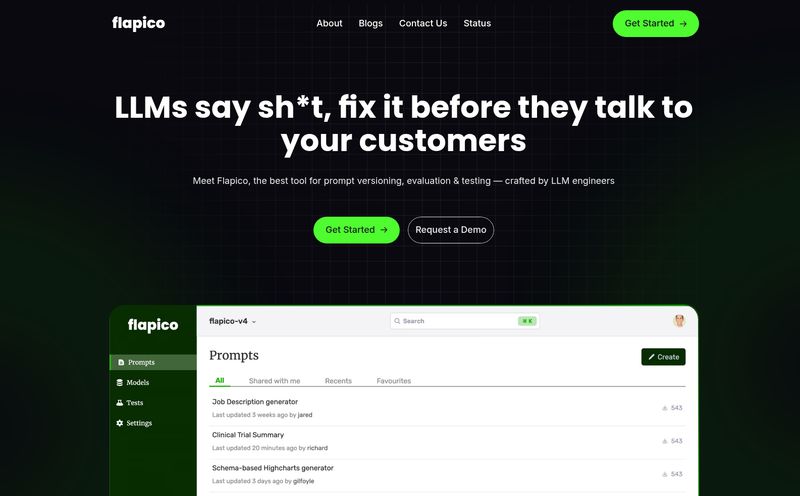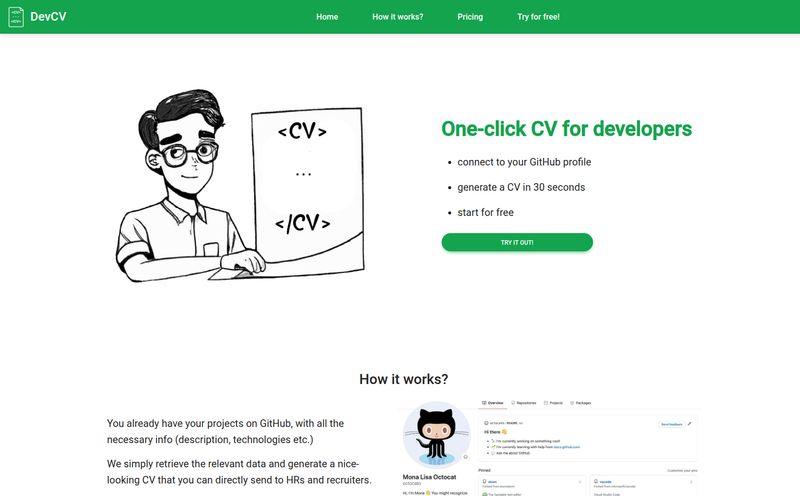In the world of SEO and web development, you get a little jaded. Every week, there's a new AI tool that promises to revolutionize your workflow, write your content, design your site, and probably walk your dog. Most of them are... well, they're fine. A few are genuinely impressive. But every now and then, you stumble across something that makes you tilt your head and go, "Huh. That's... different."
That was my exact reaction to Cayodis. On the surface, it presents itself as two completely different things bolted together. It's an entertainment web app for nerding out on history. And it's also a UI component generator for developers. It’s like finding out your favorite history professor moonlights as a minimalist furniture designer. Weird, but I'm intrigued.
So, is this a brilliant fusion of ideas or a tool with an identity crisis? I’ve been poking around, and I’ve got some thoughts.
So, What Exactly is Cayodis? A Tool with a Split Personality?
Okay, let's break this down. Cayodis lives a double life. On one hand, it’s a content discovery platform. Think of it as a rabbit hole generator. It uses OpenAI's Chat-GPT-4 to generate articles and blurbs on historical tidbits and general interest topics. To make things pretty, it pairs that text with illustrations created by Midjourney. If you’ve spent any time in the AI space, you know those are two of the heavy hitters. We're talking top-tier text and image generation.
But then, you flip it over, and it's a slick utility for web developers and designers. It’s a UI component generator. You literally just tell it what you want. "Create a responsive pricing card with a highlighted 'Pro' plan," or "Make a clean newsletter signup form with a blue button." It then builds it for you, right before your eyes. It’s wild.
The Main Attraction: The AI UI Component Generator
For me, and I suspect for most people reading this, the UI generator is the real headline act. We've all been there—staring at a blank screen, trying to code a simple card component and getting lost in CSS for an hour. It’s the kind of task that should be simple but ends up eating your afternoon.
How It Works (In Plain English)
The process is refreshingly simple. You're given a text box and the immense power of natural language. You just describe the component you need. You don't need to know the perfect industry jargon. You just talk to it like you would a junior developer.
Want to change something? You don't dive into code. You just tell it. "Okay, make that button orange instead." Or, "Add a subtle box-shadow to the container." You iterate with words, not with lines of frustrating, non-cooperative code. It feels less like programming and more like having a conversation.

Visit Cayodis
The Magic of Real-Time Visualization
This is the part that gave me that little gasp moment. As you type and refine your description, you see the component changing in real-time on your screen. There’s no compile, wait, refresh cycle. It’s an instant feedback loop that feels incredibly intuitive. It’s like sculpting with words. This instant feedback is a massive time-saver, cutting out the tedious back-and-forth that usually defines front-end tweaks. You know immediately if your idea works or if it looks terrible. No guesswork invloved.
I can already see solo founders and small teams getting a massive boost from this. It bridges the gap between idea and execution in a way that’s genuinely impressive.
The Other Half: An AI-Powered Content Discovery Engine
Now, about that other personality. The entertainment app. At first, I thought, why? What does a history-fact generator have to do with building UI components? And honestly, I'm still not 100% sure there's a grand, unified theory here. Maybe there doesn't need to be.
The idea is that you can discover and share interesting content about history and other topics, all generated and illustrated by AI. It’s a cool party trick, and using GPT-4 and Midjourney means the quality is likely to be a cut above the usual AI-generated fluff. It could be a fantastic source of inspiration or just a fun way to kill ten minutes while you wait for a build to finish. I see it as a very creative and unique bonus feature, a testament to the creators' playful approach. It’s not the reason you’d subscribe, but it’s a delightful perk.
Let's Talk Turkey: Cayodis Pricing
Alright, so what does this magical, slightly schizophrenic tool cost? The pricing is refreshingly straightforward, which I always appreciate. No confusing credit systems or enterprise-only smoke and mirrors.
| Plan | Price | Prompts | Best For |
|---|---|---|---|
| Basic | $5 / month | 120 Monthly Prompts | Side projects and basic component generation. |
| Pro | $15 / month | 350 Monthly Prompts | Serious developers and multiple side projects. |
My take? The $5 Basic plan is an absolute steal. For the price of a fancy coffee, you get 120 prompts. That's more than enough to build out the UI for a side project, experiment with ideas, or just speed up your workflow significantly. The $15 Pro plan is aimed at more prolific users, and with 350 prompts, it's fairly priced for freelancers or small agencies who are constantly building new things.
My Honest Take: The Good, The Bad, and The Intriguing
No tool is perfect, right? After my initial excitement, I tried to look at Cayodis with a critical eye. Here's where I landed.
What I genuinely like is the core concept of the UI generator. It's fast, it's intuitive, and it lowers the barrier to entry for creating clean, functional web components. It’s a productivity multiplier, plain and simple. The combination of utility and entertainment is also weirdly charming.
But, there are some question marks. The biggest one for any AI tool is always content quality. While it uses top-notch models, the final output is still at the mercy of the AI. For the UI generator, this is less of an issue, but for the historical content, you'd still want to fact-check anything you're using in a serious context. Also, the documentation on how much you can customize the UI components is a bit thin. Can I import my own design system tokens? How deep does the iteration go? These are questions I still have.
Ultimately, the good far outweighs the bad. The potential here is massive.
Who is Cayodis Actually For?
I've been thinking about who gets the most out of this. A few profiles come to mind:
- Solo Founders & Indie Hackers: You're the CEO, CTO, and head of design. A tool that can quickly spin up front-end components is basically a superpower.
- Front-End Developers with Deadlines: Need to mock something up fast? Tired of writing boilerplate for the tenth time? This is your shortcut.
- Students and New Developers: It’s a fantastic way to learn what's possible and see how components are structured without getting bogged down in syntax.
- Content Creators: The entertainment side could be a quirky source of inspiration for social media posts or blog ideas.
Frequently Asked Questions about Cayodis
- What AI models does Cayodis use?
- It's built on some serious powerhouses. It uses Chat-GPT-4 for text generation and natural language understanding, and Midjourney for generating the illustrations for its entertainment section.
- Is Cayodis good for complete beginners with no coding experience?
- It's certainly a great starting point! Because you use natural language, you don't need to be a coding wizard. It can help you visualize and create components, but you'll still need some basic web knowledge to implement them on a live site.
- Can I customize the generated UI components in detail?
- The premise is iterative design using language, which implies a good degree of customization. However, the exact limits—like whether you can work with highly specific design systems or frameworks—aren't fully detailed. I'd assume it's best for standard HTML/CSS components for now.
- Is the historical content from the entertainment section reliable?
- It uses GPT-4, which is incredibly advanced, but all AI-generated content carries a risk of 'hallucinations' or inaccuracies. It's fantastic for general interest and inspiration, but I'd recommend cross-referencing with a primary source for any academic or critical work.
- What happens if I use all my monthly prompts?
- Based on the subscription model, you would likely need to wait until the next billing cycle for your prompts to reset, or potentially upgrade to the Pro plan if you're on Basic.
- Is there a free trial?
- The pricing plans don't explicitly mention a free trial. Given the low entry point of the $5 Basic plan, they might be encouraging users to just dive in with that, but it's always best to check their official website for the latest offers.
Final Thoughts
So, what's the verdict on Cayodis? I walked in expecting a gimmick and walked away genuinely impressed. The dual-personality approach is still a bit of a curiosity, but the UI component generator is, without a doubt, a powerful and practical tool. It’s a smart application of AI that solves a real, tangible problem for people who build things for the web.
Will it replace front-end developers? No, of course not. But will it make their lives easier, faster, and more creative? I absolutely think so. For five bucks a month, it's more than worth taking for a spin. You might just find your new favorite, slightly weird, co-pilot.



